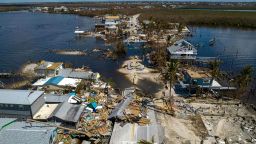Editor’s Note: Cara Cuite is a health psychologist and assistant extension specialist in the department of human ecology at Rutgers University. Rebecca Morss is a senior scientist and deputy director of the Mesoscale and Microscale Meteorology Laboratory at the National Center for Atmospheric Research. The views expressed here are their own. Read more opinion on CNN.
More than 100 people died as Hurricane Ian struck Florida. Why was this storm so deadly? As researchers who study how people make evacuation decisions before coastal storms, we believe that it is critical to understand the features of this storm – and the communication about it – that contributed to its deadliness.


Meteorologists’ forecasts of Ian’s probable track changed as the storm approached landfall, as forecasts typically do. In this case, the storm veered south, and areas such as Lee County, which 72 hours in advance were thought to have lower chances of a direct impact, ultimately were directly in Ian’s path.
Ian also underwent rapid intensification, perhaps influenced by climate change, which meant that its wind speeds increased dramatically as it passed over the warm waters of the Gulf of Mexico before landfall.
Emergency managers typically need at least 48 hours to successfully evacuate areas of southwest Florida. However, voluntary evacuation orders for Lee County were issued less than 48 hours prior to landfall, and for some areas were made mandatory just 24 hours before the storm came ashore. This was less than the amount of time outlined in Lee County’s own emergency management plan.
While the lack of sufficient time to evacuate was cited by some as a reason why they stayed behind, there are other factors that may also have suppressed evacuations in some of the hardest hit areas.
In order to correctly follow evacuation orders, people need to first know their evacuation zone. Research from other areas of the country indicates that many people don’t. That’s why the evacuation zone locator websites in the affected counties were crucial. However, so many people were checking their zones that some of these websites crashed in the days before the storm.
Our own research (and others’) indicates that mandatory evacuation orders can lead to higher evacuation rates than voluntary ones. It is possible that first hearing that their area was under a voluntary evacuation order may have lulled some residents into being less concerned and less likely to take action once the evacuation became mandatory. It also may have led to confusion about what people were supposed to do in the crucial days and hours before the storm’s landfall.
In areas where evacuation orders were issued later, people who weren’t expecting to evacuate needed to find and understand this evacuation zone information quickly. In addition, it takes time to communicate evacuation orders throughout a community, and for people to decide what to do, pack belongings, find a place to go and arrange how to get there, often in the midst of heavy traffic and other complications and obstacles.
Also important in Ian was how prior personal experiences with hurricanes influence people’s decisions. Some areas devastated by Ian have had several close calls with hurricanes in the recent past, including with Hurricanes Charley and Irma. While these storms affected many of the same communities, they did not have the same impacts as Ian, which may have created a false sense of security among some residents.
As Fort Myers city council member Liston Bochette III said, “Obviously, about one time in ten when they warn you, it happens. Well, this is that one time. And people did not evacuate as they should have. And I think we’re lulled into … this is a little paradise corner of the world and we got lulled into a passive mindset that it’s not going to hit us.”
In addition to a false sense of security from prior near-misses among some residents, others who were in the areas of Florida hardest hit by Hurricane Ian may not have had any personal experience with such powerful storms. This is likely true for the millions of people who have moved to Florida over the past few decades, especially those who moved from areas where hurricanes are rare or do not occur. In Ian, as in some past storms, some people recognized the danger too late.
It is still too early to draw conclusions about what lessons can be learned from the communication successes and failures in the lead up to Hurricane Ian, but some things are clear. People need to know that they are in an area being asked to evacuate – and waiting until the storm is on its way to find out their zone may be too late. Emergency managers need to educate people in advance of imminent storms while also developing more robust websites to handle the queries in the days before the storm.
Public officials and the media should continue to provide concrete information about where, how and why to evacuate, which can be critical factors in people’s decisions to leave.
Get our free weekly newsletter
- Sign up for CNN Opinion’s newsletter.
- Join us on Twitter and Facebook
Many lists of available shelters included clear indications of whether they were pet friendly or could accommodate individuals with special needs, which was likely helpful to the more than 33,000 people who used the public shelter system. However, among those who did not evacuate, pets and disability continue to be cited as reasons, indicating that more outreach and evacuation support is needed in these areas specifically.
Hurricane Ian focused residents’ attention on important elements of storm preparedness, such as their evacuation zones. For future storms, it will be important to continue to help people, especially the most vulnerable, understand how and why to evacuate, often under quickly shifting forecasts. Hurricane Ian demonstrated that sometimes the worst-case scenario really does happen.





